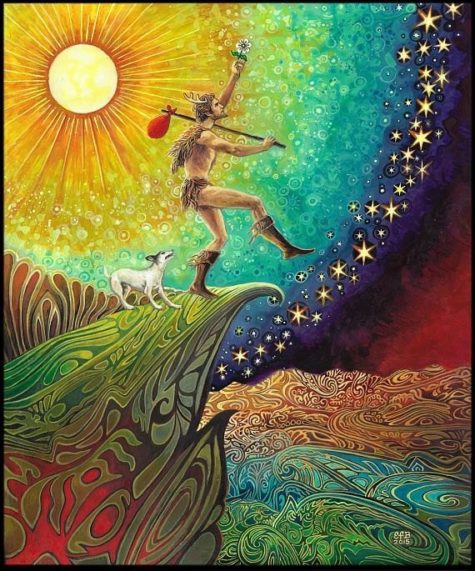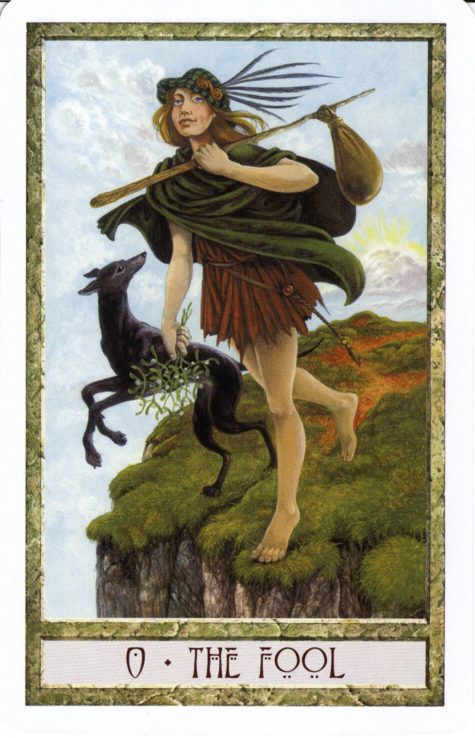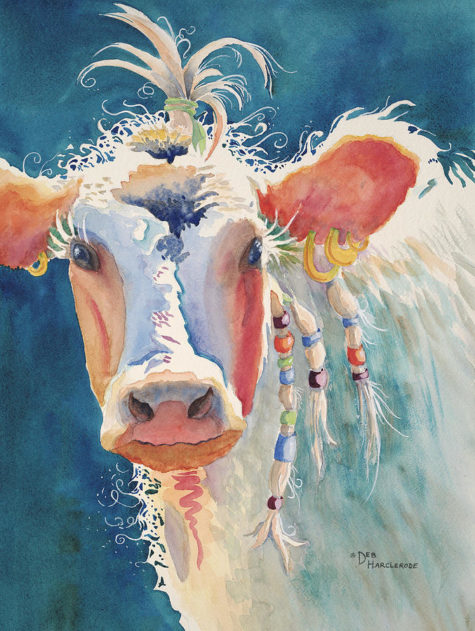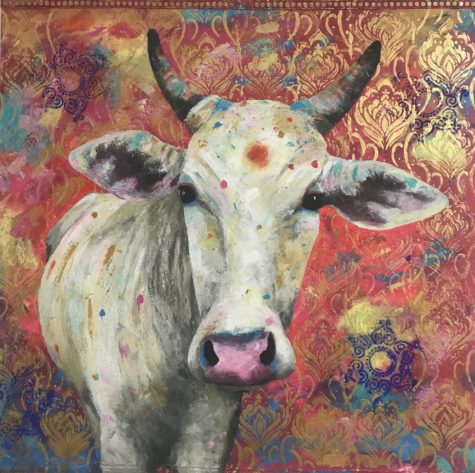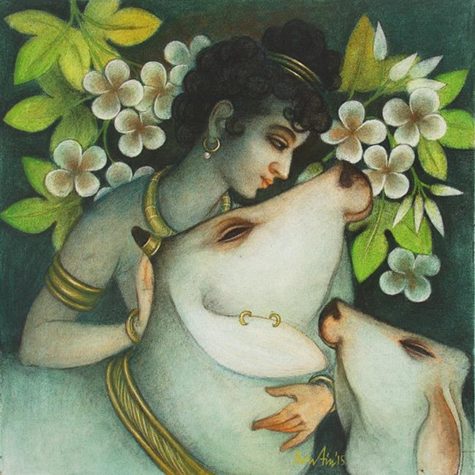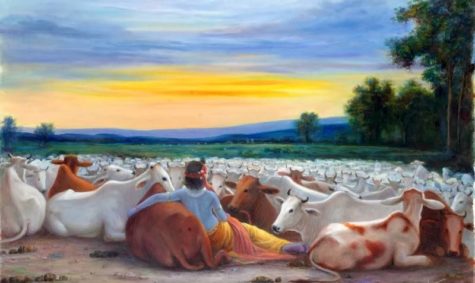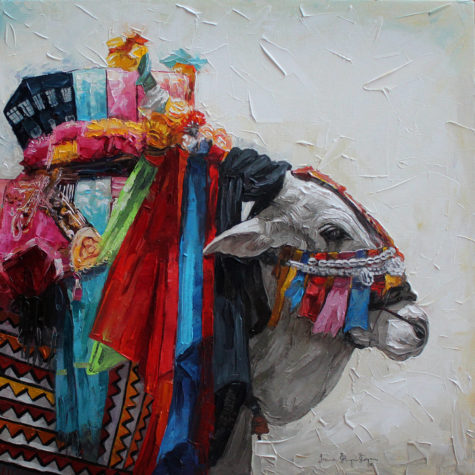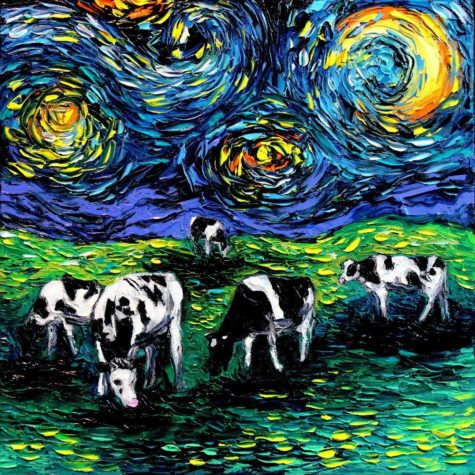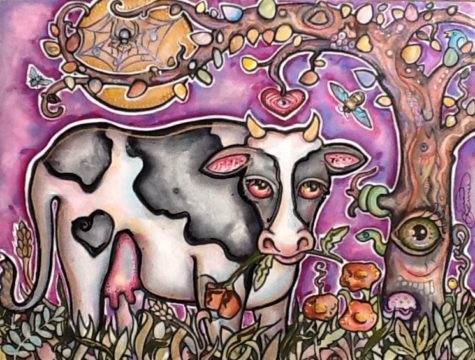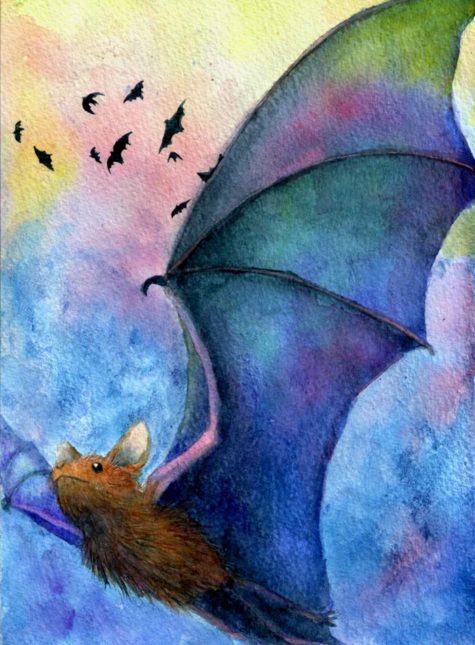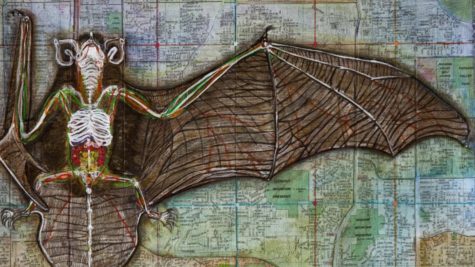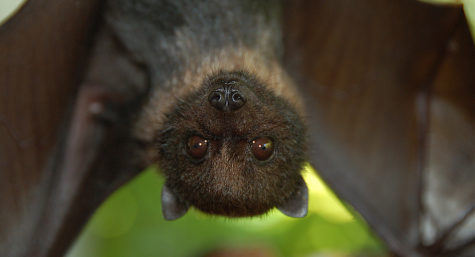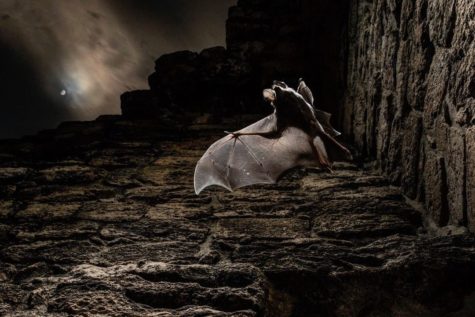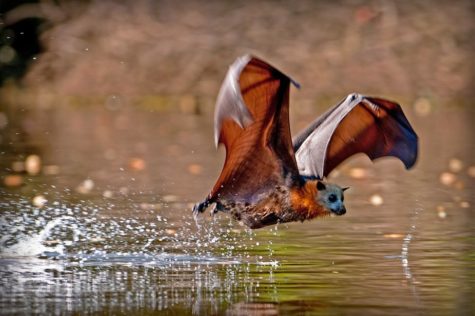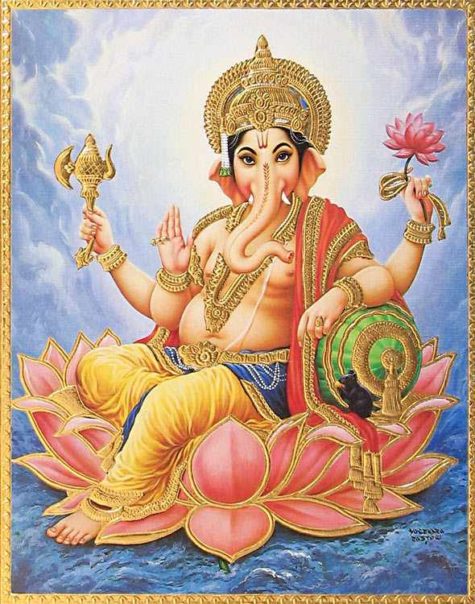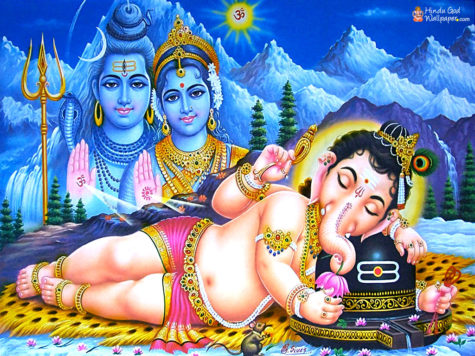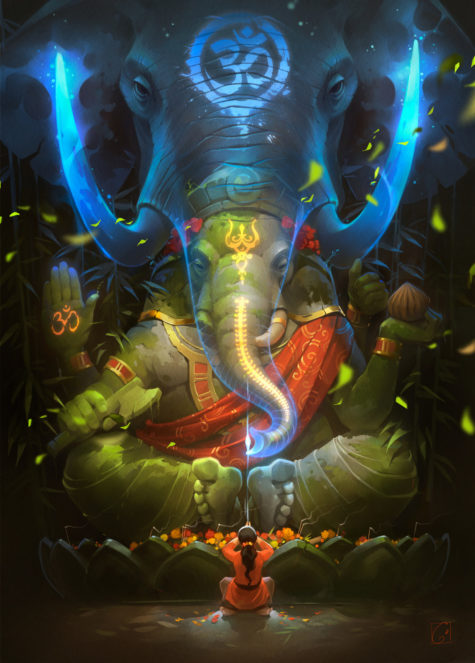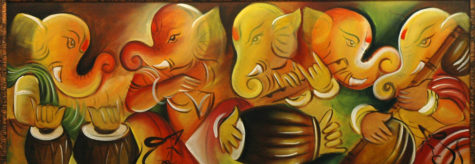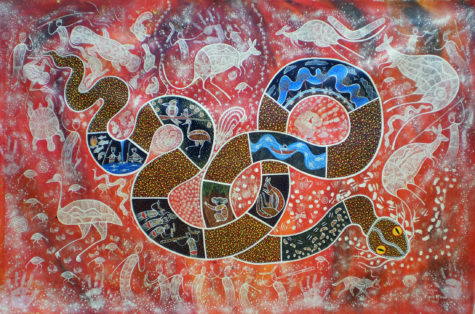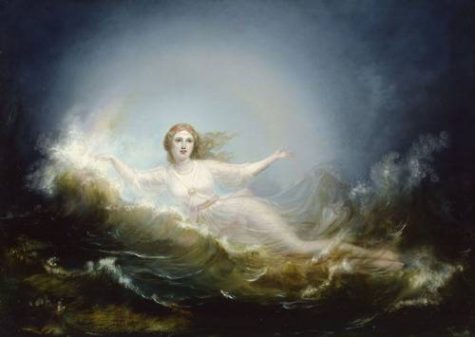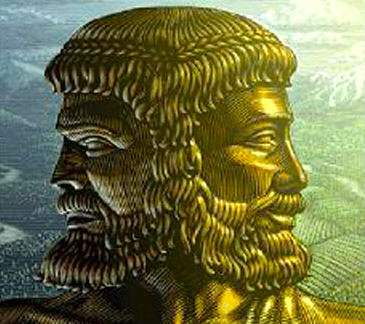Beginnings
The Fool is the spirit in search of experience. He represents the mystical cleverness bereft of reason within us, the childlike ability to tune into the inner workings of the world. The sun shining behind him represents the divine nature of the Fool’s wisdom and exuberance, holy madness or ‘crazy wisdom’. On his back are all the possessions he might need. In his hand there is a flower, showing his appreciation of beauty. He is frequently accompanied by a dog, sometimes seen as his animal desires, sometimes as the call of the “real world”, nipping at his heels and distracting him. He is seemingly unconcerned that he is standing on a precipice, apparently about to step off.
Here are some key phrases that can be used to describe this card:
- entering a new phase
- striking out on a new path
- expanding horizons
- starting something new
- beginning an adventure
- going on a journey
- heading into the unknown
- being spontaneous
- living in the moment
- letting go of expectations
- doing the unexpected
- acting on impulse
- feeling uninhibited
- surprising someone
- feeling carefree
- having faith
- trusting the flow
- staying open
- letting go of worry and fear
- feeling protected and loved
- living in joy
- recapturing innocence
- believing
- embracing folly
- accepting your choices
- taking the “foolish” path
- pursuing a pipe dream
- being true to yourself
- taking a “crazy” chance
- trusting your heart’s desire
One of the keys to the card is the paradigm of the precipice, Zero and the sometimes represented oblivious Fool’s near-step into the oblivion (The Void) of the jaws of a crocodile, for example, are all mutually informing polysemy within evocations of the iconography of The Fool. The staff is the offset and complement to the void and this in many traditions represents wisdom and renunciation, e.g. ‘danda’ (Sanskrit) of a Sanyassin, ‘danda’ (Sanskrit) is also a punctuation mark with the function analogous to a ‘full-stop’ which is appropriately termed a period in American English. The Fool is both the beginning and the end, neither and otherwise, betwixt and between, liminal.
The number 0 is a perfect significator for the Fool, as it can become anything when he reaches his destination as in the sense of ‘joker’s wild’. Zero plus anything equals the same thing. Zero times anything equals zero. Zero is nothing, a lack of hard substance, and as such it may reflect a non-issue or lack of cohesiveness for the subject at hand.
In many esoteric systems of interpretation, the Fool is usually interpreted as the protagonist of a story, and the Major Arcana is the path the Fool takes through the great mysteries of life and the main human archetypes. This path is known traditionally in Tarot as the Fool´s Journey, and is frequently used to introduce the meaning of Major Arcana cards to beginners.
The conventional explanations say that The Fool signifies the flesh, the sensitive life, depicting folly at the most insensate stage. When The Fool appears in a spread, he is a signal to strip down to the irreducible core, and interrogate whether the Querant’s self-vision is obscured. It may also be a warning that significant change is coming. Another interpretation of the card is that of taking action where the circumstances are unknown, confronting one’s fears, taking risks, and so on.
From: Information collected from various sources.
Because of its milk that is a staple food for many human beings, the Cow is arguably one of the most useful animals in the world. It was one of the first animals domesticated by humans, and its symbolic importance is rich. It is emblematic of fertility, abundance, wealth, the universal Mother, and of rebirth. The Cow is also a gentle and compliant creature.
In Vedic literature the Cow is also a symbol of abundance and fertility as it represents both earth and sky. To Hindus and Buddhists, symbolism of the Cow deals with patience and holiness.It is considered India’s most sacred animal. The calm, tender nature of the Cow wins this right among the Buddhists.
The Cow as a sacred animal is a fundamental part of Hindu iconography. In India the Cow is so revered, and treated so gently, that it often causes a traffic hazard as it ambles along busy city roads. There are several reasons for the sacred status given to the creature. Not only does the Hindu faith have respect for all animals (vegetarianism is a tenet of the faith), but the God Krishna was a cowherd for a time, and one of his names is Bala Gopala, “the child who protects the cows.”
Hindu deities rule over each and every part of the Cow. During times of famine, the Cow is far more useful as a creature that can produce limitless amounts of milk, then as a dead beast that would provide meat for a limited period only.
In Egypt the Cow was personified as Ahet, the mother of the Sun itself. To make themselves fertile Egyptian women wore amulets of the Goddess Hathor, with the head of a Cow, in her guise as the Creator.
In Norse mythology the Cow makes an appearance as Audhumla, the mother-ancestor of all living things, whose utters emitted the four rivers of power – these provided nourishment for the giants (primarily the first giant, Ymir) that ruled the First World.
In Celtic mythology the Cow is sacred to the Mother Goddess Brigit who also governs the Earth, mothers, children, health, nurturing, providence, and the full range of the Female element of the universe. This symbolism remains consistent with that of many other cultural settings and supports Cow as representing life’s fragile beginnings and the necessity to safeguard and restore those who have no voice or support.
In Greek myth, one of the names for the great Cow was Europa, which means “full Moon.” The stars were said to be the children of Europa.
In Lancashire folk-speech, the name “cow’s lane” was sometimes given to the Milky Way, the traditional path of souls, as it was also in some parts of Germany. This may be connected with the old north European belief that whoever gave a cow to the poor during his life would be guided by that cow along the perilous soul-road after his death, and so would be sure of reaching Heaven in safety.
Once, there was a custom whereby the cow was brought to the sickroom, and in what must have been a distressing and rather frightening ritual, the dying person was encouraged to grasp the tail of the cow as he breathed a last breath.
This psychopomp aspect of the Cow is still celebrated in the Nepali festival called the Gai Jatra or Cow Festival. In a boisterous celebration, every family that has lost a member during the course of the year has to take part in a procession, leading a Cow, or if no animal is available, then a child dressed in a cow costume is considered to be a fair substitute. The Cow is believed to guide the soul on its final journey, including a voyage through the Milky Way, the constellations of stars said to be the milk splashed by the great Cow that was the mother of the Universe.
Red cows appear in some pagan creeds as personifications of the dawn, or clouds, or lightning. It is possible that they had some special significance for the ancient Hebrews also, since it is definitely stated in Numbers 19:1 that the victim offered for the purification of the people must be “a red heifer without spot, wherein is no blemish, and upon which never came yoke.”
In England the milk of a red cow was formerly supposed to be superior to any other, and to have healing properties. Such milk is often specifically mentioned in 17th and 18th century medical books as an essential part of remedies for various ills, particularly for consumption and chest ailments. Red is, of course, a life-giving color in mythology and folk tradition alike because it is associated with fire and with blood, and red objects of various kinds figure constantly in healing charms and folk remedies.
According to a French legend, Cows always have a sweet breath because when Our Lord was born in the stable at Bethlehem, a Cow, seeing Him shivering in the cold, warmed Him with her breath and drew the hay over Him with her lips. As a reward for this act of kindness, she was promised that her breath, and that of all her descendants, should ever afterwards be sweet, and in addition, she was given the privilege of carrying her calf for nine months, like a Christian woman with a soul to be saved.
Cow Symbolism
The Cow is a lunar symbol, aligning itself with feminine (yin) qualities among the Chinese yin-yang energies. A quick-list of Animal symbolism of the Cow would include:
- Patience
- Nourishment
- Abundance
- Fertility
- Female Power
- Potential
- Possibility
- Calming
- Grounded
- Provision
- Beginnings
Because you’re seeking out Cow symbolism and meaning, a deep stirring must be happening in your soul. Cows represent motherhood, Mother Gaia, and the Mother Goddesses. Take time to meditate on all Mother Cow has to offer. She is a sacred reminder of fertility, birth, and nurturing.
- When Cow appears as your Spirit Animal trust that the mighty storm will pass and you’ll be OK.
- Cow as a Totem Animal belongs to those with profound Mother Goddess instincts.
- Call in Cow as your Power Animal when your soul needs TLC.
The Cow Totem
Those who know Cow as their Totem Animal supply a sense of stability and solid, loving, growth-oriented relationships with self, others and the environment.
Cow people have the ultimate “mother’s intuition.” They can feel when others are out of sorts – when their auras are “scratchy” – and they always seem to know just what to say or do to help. Somehow, folks heal more quickly when in the company of Cow Totem Animal people.
If Cow is your Totem Animal, always remember that one cannot feed others from an empty trough. Though you were born with the natural instinct to take care of the world, YOU are part of it. Your needs are just as important as everyone else’s. A wise Cow mama know when to take a break and nourish her own mind, body, and spirit.
We should always work to have a positive and happy home environment. If we don’t, we should inquire deep within as to how we can change that. Calling upon the Cow animal totem, we can learn how to make basic changes that are needed to balance the joys in our surroundings.
Like its family member the bull, the Cow totem is highly connected to nature, the Earth, and its continuation through reproduction. Cows are very generous with their lives and behave in the most selfless of manners.
Among fertility and femininity, these mother creatures represent the virtuous traits of sustenance, abundance, potential, calming, grounding, and provision. They also serve as an uplifting sign of female power and prestige, since they are, after all, crucial to the continuation of any species.
New beginnings are also a theme associated with Cows in conjunction with their maternal auras. Through their pregnancy, birth, nourishment to their offspring, and ultimate bodily gifts, Cows show the entire life cycle in its bittersweet beauty from start to finish.
The female Cow totem is linked to its male counterpart, the bull, through the symbolism of fertility and reproduction. While the male totem exemplifies nourishment through its slaughter or sacrifice, a Cow symbolizes birth and motherhood.
Cow symbolism assists us in understanding and embracing fertility and the relationships necessary for it. It is a soft and nurturing creature that arouses the soft side in each of us. The two animals are directly connected, as they are both needed to create new life.
These animals illustrate both the masculine and feminine qualities that exist in every being. The bull is characterized by bold and rigid energies, while the Cow is far more gentle and tranquil. They remind us to constantly ensure that these energies are in harmonious balance.
Cows As Spirit Guides
The Cow is a very powerful Spirit Animal. While at first you might wonder about the value of such a guide in your life, there is much about Cow to respect.
Like many other animals, Cows as spirit guides have been revered in various religions and cultures around the world. In ancient Egyptian astrology, the Cow served several symbolic purposes, including being worshiped as the goddess of joy and maternal nourisher of all things.
Additionally, they remind us to nourish ourselves physically, mentally, and emotionally. If we neglect the basics of our lives, it will be impossible for us to live happily and thrive. Every day, you should ask yourself if you are eating the right foods, drinking enough water, and exercising both your body and your mind to remain healthy and alert.
Cow reaches out to those struggling with fertility offering motherly advice. You may not always like what Cow tells you (did you like everything your mother told you?), but the heart behind the Cow Spirit Animal is truly one of giving. She always wants what is best for both you and your proverbial herd.
When weathering a storm, be it emotional or physical, turn to Cow as your animal spirit guide and think of how firm Cows stand in vile weather. There is no moving a Cow and no influencing it, but for urgent matters of hearth and heart. Nonetheless, as you stand in your place of power, remember that Cow also gives you keen perceptions. Be on the alert for possibilities or potential peril.
If your spiritual path is working toward the greatest good, Cow guidance is a fantastic helpmate. She will stay with you compassionately with watchfulness, making sure you stay inside the spiritual boundaries you’ve set.
Cows are lunar, divine feminine energy. If you’ve ever looked into a Cow’s luminous eyes it’s easy to feel how loving they truly are. But, as soft and magickal as moonlight is, never forget it is the moon which is mighty enough to influence all the waters of the earth. The divine feminine is just like that. Pliable and giving, but it should never be mistaken for weak.
Cows are a simple creature that get their joys from life’s basic pleasures. From this, they aid us aid us in remembering to be easy going and live in the moment. Often times, we ignore the innocent and plain moments that make our lives wonderful.
If we can manage to clearly assess our lives, we will be reminded to thank our family members and those close to us for all that they do to make our lives joyful. Simply appreciating your community can change your mentality greatly, having positive effects on both your outlook and your body.
One of the Cow symbol’s main spiritual messages is to never take this for granted, for eventually this life will end.
Cow As A Power Animal
If you want to have children, consider carrying a carved Cow totem and invoke Cow as your Power Animal. Cows are powerful symbols of new life. That life need not necessarily be as a parent however. It can apply to new jobs, new homes, and new relationships.
Keep a Cow totem on hand when you need protection from negativity or nightmares. Like the Mother Goddess herself, Cow energy holds you close, reassuring that nothing will harm you.
As a power animal Cow calls on you to love fully. Look at the world and the wonders of creation and let that fill you with all the characteristics you most need to embrace life.
Note, however, that this power animal will not let you give and give and give without refilling. Those that serve need service, including you. Put out a cattle call and let people give back (it blesses them too).
Dreaming About Cows
Lessons of gratitude and the appreciation of sacrifice are prevalent in cow symbolism, especially when presented in our dreams, and we would do well to integrate them into our daily life.
A cow dream symbolizes some important issues. In Hindu culture, cows are sacred and represent fertility, nourishment, and motherhood. Cows also represent personality traits such as passivity and overall contentment. Seeing a cow in a dream is usually a positive thing, with the appearance of grazing cows, in particular, representing happiness and prosperity. Some ancient societies and some tribal societies measure a person’s wealth by how many cows he or she has.
The dream cow indicates that you obey authority figures without questioning them. It may represent maternal feelings or a desire within you to be taken care of. If you see a herd of cows in your dream, it suggests that you have a strong need to belong to a group. A herd of cows may also mean that you have a group of close friends that you enjoy. If the herd was disturbed or anxious in some way, it means that something or someone may be acting on your group of friends in such a way as to cause trouble and pull the group apart.
Dreaming of a field full of Cows portends improved finances or potentially a multiple birth in the family. A Cow grazing happily speaks of joy and contentment in the home. If the Cow represents self, it’s a signal that you need nurturing and spiritual nourishment.
The appearance of a cow with the face of a skeleton in your dream means that your mother or some mother figure in your life is acting coldly toward you or not responding to your needs. If you dream of cow with a calf, this is always a positive sign.
If you dream of being a cow, this suggests that you are afraid of being stupid. Dreaming of a sick cow suggests that some plans you’ve made for the future are threatened and require some action from you to avoid problems.
Because cows often represent motherhood, they are also representative of the feminine part of a man’s psyche. If you are a man, the dream of a cow suggests that you recognize this part of yourself and incorporate it into your life in order to attain greater psychological balance overall.
Dreams of cows are symbolic of peace, passivity, endurance, mothering, and humility.
Superstitions About Cows
An old English superstition says that cows kneel down on Christmas Eve and pay homage to Jesus. They speak in human voices, but anyone who hears them will die before being able to tell anyone about it.
Old farmers say that every herd has a “master cow” which leads the others into mischief. If a cow lows after midnight, it is a death omen for someone in the neighborhood, and similarly, if a cow lows three times in a man’s face, he has not long to live.
If a cow licks the forehead of another cow, it is a sign that their owner is about to die. It is also a sign of imminent death if a cow enters your property. Three cows means three deaths. Yet another reason for keeping your gates closed, especially if you live in the country!
It is important to wash your hands thoroughly after milking a cow. If you don’t, you will receive no milk on the following day.
- Cows that eat buttercups produce tastier butter.
- When out in the field an upright Cow tail foretells rain.
A cow’s breath is believed to have health-giving properties and people suffering from tuberculosis were at one time encouraged to sleep with the cattle.
If separating a calf from its mother, you should take a calf out of the barn backwards to prevent its mother mourning the loss of her child.
In Ireland a hare appearing with Cows on Beltane signify witches who are up to no good stealing away with fresh milk. The Scots believed that putting tar behind the Cows’ ears would keep the witch from succeeding.
Witches were also believed to be able to steal the milk of cows from a distance by means of a magical tether, the strands of which were plaited the wrong way. They could do the same by going through the motions of milking with a rope, or a pot-hook, or the legs of a stool, and sometimes they came in the form of hares and sucked the udders of cows lying out in the fields. When the true milking-time came around, such bewitched animals would give only a poor supply or no milk at all.
Various charms were used to counteract these thefts, one of which was to make the rope used to tether the animals’ feet out of horsehair, and to thrust a stick of rowan, or some other magickal wood, through it.
In an article in Folk-Lore (1895), a story is told about a Bernera farmer whose cows gave so little milk that he was sure they were bewitched. He used such a rope, with excellent results; but as soon as the cows were released, they all rushed to a certain woman’s house and began tossing at the walls. This was regarded by the local people as clear proof that the woman had previously bewitched them, and so strong was the feeling against her on this account that she had to leave the district.
In Discourse on Sympathy (1658) an old country belief is recorded that if milk boiled over and fell on the fire, salt must immediately be thrown on the place where it fell. If this was not done, the cow which gave it would suffer from an ulcerated udder.
Sources:
- Animal Speak by Ted Andrews
- What Is My Spirit Animal?
- The Encyclopedia of Superstitions
- Element Encyclopedia of Secret Signs and Symbols
- What’s Your Sign
- Keynote: Transition and Initiation
- Cycle of Power: Nighttime
The bat is one of the most misunderstood mammals. Modern depictions in movies and television have given it a sinister reputation, but it plays an important role in Nature and as a symbol in the totem traditions. Although more modern lore places the bat in cohorts with the devil, with its dragon-like wings, in more ancient times it was a powerful symbol.
In Babylonia bats represented the souls of the dead. In China they were symbols for happiness and long life. To the ancient Mayans, they are symbols of initiation and rebirth. To the medieval peoples, they were miniature dragons.
From the early Meso-America traditions came a sacred book of the initiatory process in which bats hold a significant role. This book was called the Popol Vuh It was discovered by Father Ximinez in the 17th century. (You can read excepts from it on Widdershins). The second book of the Popol Vuh describes the seven tests that two brothers must undergo The seventh test took them into the house of bats. Huge bats flew through the labyrinth and it was overseen by Camazotz, the god of bats. This being had the body of a human, the head and wings of a bat, and carried a great sword by which he would decapitate unwary wanderers.
This powerfully symbolic story and imagery reflects the process of transition – part human and part bat (animal). It implies a loss of one’s faculties if unwary about the changes. It also holds the promise of rebirth and coming out of the darkness.
The authors, Jamie Sams and David Carson, refer to the bat as reflecting the traditional shaman’s death – the breaking down of the former self through intense tests. It is a facing of your greatest fears – that it is time to die to some aspect of your life that is no longer suitable for you.
Most people fear transitions, holding onto a “better the devil you know than the one you don’t” kind of attitude. If a bat has flown into your life, then it is time to face your fears and prepare for change. You are being challenged to let go of the old and create the new.
For many, change is always distressing. When the bat comes into your life, you may see some part of your life begin to go from bad to worse. That which worked before may no longer. This is not negative though! And it will only be upsetting to the degree that we are emotionally attached to the old way of life or to the degree we focus on the past rather than the infinite possibilities of the future.
Changes and transformations are blessings. They are not triggered from without but from within; and the world is our mirror. As we change, even within our consciousness, everything reflected with the world also begins to change. To understand and enjoy the blessing of change, begin by taking or renewing responsibility for your life. This means opening to the power within which will override all fears.
Look beyond the immediate and limited circumstances. There can be no death without there also being rebirth. Everything reflects the divine. Remember that fear and death is choosing to block or go against the Divine energies that are yours by right of inheritance. Rebirth and life are found by choosing to follow the flow within. The choice is always ours. Remember that each time you trust your inner promptings, you chase the fears within the dark corners of your mind away.
- What you choose to do today will have repercussions for years down the road.
- Do you want those repercussions to be positive or negative?
Though small in stature, the bat is a powerful symbol. Its medicine is strong and can even be traumatic. It is a nocturnal animal, and the night was often considered the home of fears. Home fires and lights are often used to chase back the night and the fears rather than facing them and transmuting them.
- Are you avoiding something that is inevitable?
Sometimes bats are a symbol of facing our fears. They have very sharp, needle-like teeth. They can also be carriers of rabies. Rabies is an infectious disease of the blood, created by a virus. It was often associated with madness. Fears that are allowed to spread, uninhibited, will eventually permeate our system and can create a kind of madness within our lives. Bats can reflect a need to face our fears. The imaginings that result from fears that are incubating are often much worse than the actual facing of the fears, themselves.
- What are you most fearing right now?
From a naturalistic view, bats are not sinister. They play a very valuable role in nature. They feed on insects and are essential to the pollination of many plants. Their waste product, guano, is also used as a valuable fertilizer. This hints that every aspect of facing our fears will have value to us, no matter how messy it may seem to be. It holds the promise of empowerment.
The bat is also the only flying mammal. Its tremendously elongated finger bones support the wings which are made of a tough leathery skin. Its flight seems fluttery and jerky, but it is flight nonetheless All flight implies a rising above.
Because humans are mammals as well, the bat is an even more important symbol for us. It becomes a symbol of promise amidst the sometimes chaotic energies of change. It reflects the ability to move to new heights with the transitions. Yes, our own flights may seem fluttery and jerky, but we will be able to fly.
We will not only be able to fly as a result of the changes, but we will be able to see the world from an entirely new perspective. Bats sleep with their heads down. This posture has always reminded me of the Hanged Man card in the tarot deck.
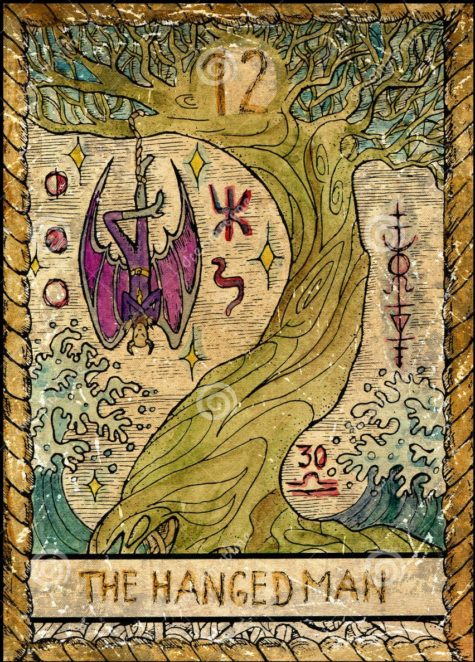 This card reflects the piercing of new barriers and the opening to higher wisdom. It symbolizes a new truth being awakened. It also implies great strength and stamina to handle the ordeals that may beset you as you open to new consciousness. Its message contains the promise of new horizons and unexpected views about to manifest. Meditation upon this card would be most beneficial for those with a bat as a totem.
This card reflects the piercing of new barriers and the opening to higher wisdom. It symbolizes a new truth being awakened. It also implies great strength and stamina to handle the ordeals that may beset you as you open to new consciousness. Its message contains the promise of new horizons and unexpected views about to manifest. Meditation upon this card would be most beneficial for those with a bat as a totem.
The bat is actually a sociable animal. It lives in flocks and thus its appearance usually reflects either a need for more sociability or increased opportunity with greater numbers of people.
The bat has a medicine which awakens great auditory perception. The idea of “blind as a bat” is wrong. Bats are not blind, and their eyes are large and developed. They can easily navigate by sight in lighted situations.
On the other hand, they are expert at maneuvering through the dark. They have a form of sonar in their nose that gives them perfect navigation. Their ability at echo-location enables them to perform amazing flying feats even within the flock. They rarely, if ever, collide. This sonar and echo-location can be linked metaphysically to the gift of clairaudience or clear-hunting. It awakens the ability to hear spirit.
Those with a bat as a totem will also find that they have an increasing ability to discern the hidden messages and implications of other people’s words. Listen as much to what is not being said. Trust your instincts. The nose is the organ of discrimination, and with its sonar located in its nose, the bat reflects the ability to discriminate and discern the truth in other people’s words.
The bat is powerful medicine. It can be trying, but it always indicates initiation – a new beginning that brings promise and power after the changes.
From: Animal Speak by Ted Andrews
Elephant-headed Ganesha may be the most beloved deity of the modern Hindu pantheon; venerated by millions. He is invoked by Buddhists, Jains, and Neo-Pagans, too. He is benevolent and generous to all.
- Titles: Lord of New Beginnings; Lord of Obstacles; He Who Bestows Blessings
- Also known as: Ganapati
- Origin: India
- Color: White, Red, Pink
- Element: Water
- Numbers: 1, 3, 5
- Animals: Mouse, Snake
- Mount: Mouse
Lord of Beginnings, Ganesha’s blessings are sought before initiating any new enterprise. Ganesha is the Lord of Obstacles, removing but also creating them, sometimes from anger but sometimes just to attract further veneration. The flip-side of Ganesha is that he must be propitiated before new ventures lest he place obstacles in your path.
Ganesha bestows success, victory, prosperity, material comfort, romance, love, better six, and supernatural powers and skills to his devotees. He can block all these things, too, although he is unlikely to do so unless insulted and angered.
Ganesha is a generous, sympathetic spirit, quick to bestow favors. He is a trickster, but on behalf of his devotees and those he loves. Ganesha has a fast, volatile temper, but he calms down quickly too, and can be soothed and appeased. Just remember the old saying: “An elephant never forgets!”
- Ganesha is the first deity worshiped during Hindu rituals.
- His is the first image at the head of all processions.
- He is an indispensable component of all Hindu ceremonies except funeral rites.
In The Beginning
Historical evidence indicates that Ganesha was known as early as 1200 BCE, however surviving depictions are rare before the fourth century CE. He was incorporated into the Hindu pantheon comparatively late, in approximately the 5th century.
Ganesha is believed to have begun his incarnation as a pre-Aryan elephant spirit venerated by jungle tribes. In addition to this other gifts, he was invoked for protection from elephant herds.
He was absorbed into the Hindu pantheon as the son of Shiva and Parvati. Various myths explain why Ganesha has an elephant head. In one, Parvati creates her son from the scrapings of her own skin. Ganesha was born while Shiva was away long-term practicing austerities.
Ganesha is extremely close to his mother. When she asked him to guard her privacy in the bath, he took up his position at the door. This was the moment Shiva returned. Father and son didn’t know each other. Shiva wished to see Parviti; Ganesha refused to let him pass. Shiva beheaded him. Parvati came to see the source of the commotion and was distraught. Now comprehending the situation, Shiva revived Ganesha but was forced to find a new head. The first to be had was an elephant’s.
Petitioning Ganesha
Ganesha is lord of entrances, thresholds, and crossroads. Let him guard your door. It’s traditional to place his image above main entrance thresholds so that he is always encountered when entering.
Ganesha is happy to be venerated alongside other deities; however, never forget that he is the Lord of Beginnings. If you feed him, feed him first before any other spirits. There may be conflict if you venerate him alongside other spirits who also expect to be first served, for instance, Elegba.
- Ganesha heals physical, spiritual, and emotional ills.
- Ganesha has the power to liberate from the karma of past lives.
- He is invoked for children by the childless.
Petition him at a home altar or in a temple. Ganesha is the subject of a fertility ritual conducted at his temple in Madurai, India; allegedly if you bathe his image and circumambulate around it for forty-eight consecutive mornings, he will grant your wish for children.
Ganesha is a popular tantric deity, too. His trunk and single tusk are phallic symbols. Early Hindu texts suggest disapproval of Ganesha who was then associated with “orgiastic rituals.” He remains associated with Tantra among Buddhists. Ganesha communicates with devotees in dreams.
More information can be found at Loving Ganesha. Here are links to some of the individual posts:
- Ganesha Road Opener Ritual
- Ganesha Road Opener Oil Blend
- Making A Shrine To Ganesha
- The Ganesh Mantra
- The Ganesha Oracle
Favored People:
Ganesha will allegedly favor anyone who approaches him with a pure heart. He is the special patron of musicians who play the tabla and/or mridangam (percussion instruments), as well as authors, poets, and writers. In Thailand, Ganesha is considered patron of elephant trainers.
Manifestation:
Ganesha has an elephant’s head on a man’s pot-bellied body. He has one broken tusk. His skin usually has a rosy hue. His big ears signify his capacity to listen and hear. His forehead is marked with vermilion, indicating his tendency to involve himself in issues associated with women and his generosity toward female devotees.
Iconography:
There are countless images of Ganesha sitting, standing, dancing, or riding his mouse. Once you know what he looks like, he’s very recognizable.
Realm:
Ganesha’s home is a celestial realm called the Abode of Bliss (Svaanda Dhama). He lives in a marvelous palace surrounded by a forest of wish-fulfilling trees and an ocean of sugarcane juice.
Offerings:
Ganesha is easy to please, but he cannot be fooled. He will accept the most modest offerings but only if given with sincere intent and devotion. His favorite offering is said to be modaka, a type of sweet rice or wheat cake. Here’s a recipe: Recipe For Modaka. Allegedly the more modaka you give him, the more inclined his is to work on your behalf. Ganesha also accepts peanuts; fruits, especially bananas; sweets, candy, and sugarcane.
Source: The Encyclopedia of Spirits
- Other names: Damballah Weddo, Da, Papa Damballa, Obatala
- Manifestation: Damballah is a huge snake, so big his body forms seven thousand coils
- Color: White
- Day: Thursday
- Plants: Bougainvillea, trees in general, but especially the silk cotton tree (Bombax ceiba) and the Royal palm.
- Altar: Keep shallow vessels of clean, fresh water for him to curl up inside.
- Holiday: March 17 (St. Patrick’s Day)
Once upon a time, there was only Damballah. He lay beneath Earth, a great snake, cushioning and protecting it from falling into the watery abyss below. Although he lay still for a long time, eventually he had to move. His movements raised mountains and created valleys. Stars were shaken up into the sky. Sacred waters were released, forming oceans, rivers, springs and streams.
The first rain began to fall, and Aido-Hwedo, in the guise of the first rainbow, appeared. Damballah and Aido-Hwedo fell in love. They remain in love today. The intensive all pervasive power of that love infiltrated the entire universe. That power is manifest in human beings in the form of white liquids: milk and semen.
Associated Catholic Saint Patrick (who drove the snakes out of Ireland), and sometimes also Moses, whose staff transformed into a snake to prove the power of God over that wielded by Egyptian priests, Damballah is the primordial snake Iwa of life, wealth and wisdom. He is venerated in Dahomey as well as Haitian Vodou. He may also survive in the New Orleans folk saint Blanc Dani.
Damballah is among the most beloved and important Iwa. He associated with creation and is viewed as a loving father to the world. His presence brings peace and harmony. He bestows wealth, prosperity, good health, and fertility to devotees and can expose the location of missing treasure.
Damballah and his true love, the rainbow serpent, maintain the balance of forces, which sustains all ife on Earth. As a source of life, he is also strongly associated with water and regulates moisture and the rain.
He is incredibly old and powerful and is usually not bothered for trivial matters. He can be extremely generous, however, and so may be approached when one is genuinely desperate or really in trouble. Despite his venerable age, he remains interested in people. He will engage in sacred marriages with women but also occasionally with men.
Dambullah appears in dreams. He does not communicate well. You must pay attention. He is so old and primal that he is pre-articulate; he emerges from a time before speech. Damballah may hiss or make whistling noises but does not speak human language.
When he possesses a human, he does not speak but instead only hisses and whistles. His movements are also snake-like, and can including slithering along the ground, flicking his tongue, and climbing tall objects.
He is a stickler for cleanliness. He doesn’t like strong, pervasive odors of any kind, but especially tobacco. If you smoke, then do so far from his altar space or anywhere associated with him. He may object to cleaning products with strong odors too, as well as air fresheners with strong aromas. Rooms should smell clean and fresh. Open a window to aerate them. He does not object to light floral odors, like rose or orange blossom water, and traditionally expresses a fondness for Pompeii Lotion, a cologne product found in botanicas and spiritual supply stores.
Offerings:
For a very traditional offering, make a bed or hill of white flour on a perfectly clean, pure white plate. Nestle one whole, raw white egg into the center of the flour and serve.
Other offerings could include white candles and white foods like rice, milk, whole raw eggs (leave them plain or rub gently with rose or other mildly scented, fine quality floral water), corn syrup, white chickens, or white flowers. More lavish offerings might include luxurious white fabrics, crystal or porcelain eggs and/or snakes.
Veve for Damballa and Ayida-Weddo:
From; Encyclopedia of Spirits
- Titles: Daughter of Nature, Goddess of Creation, Water Mother, Sky Mother
- Other Names: Luonnotar, Luonotar
- Origin: Finland
- Depicted as: Virgin floating on the sea
- Feast day: August 26
The name Ilmatar is derived from the Finnish word ilma, meaning “air,” and the suffix -tar, denoting a female spirit. Thus, her name literally means “female air spirit.” In the Kalevala she was also occasionally called Luonnotar,which means “female spirit of nature” (Finnish luonto, “nature”)
The story is as follows:
In the beginning, says the Kalevala, there was only Ilmatar, the void and a great deal of wind. She was alone in the beginning of time. She lived in the heavens, but eventually she grew restless and slipped into the vast cosmic sea. She floated and frolicked for centuries on this primordial ocean, counting rainbows and letting the wind play in her hair.
She began to long for a son.Her longing was so great that the East Wind itself took pity. She found herself buffeted and tossed by the wind’s tempestuous love-making until, exhausted, she could bear it no longer and collapsed. During this storm she became pregnant. And there, inside her, was conceived Vainamoinen, the child of the wind.
The goddess floated for centuries on this primordial ocean, unable to give birth because there was no land. She prayed constantly to the god Ukko, the highest of the gods, to help her. After seven centuries or so she began to give up hope, and Ukko took pity on her and sent a duck.
The poor bird was desperately looking for somewhere to land so she could make a nest and lay her eggs. When Ilmatar saw the bird’s predicament, she helpfully raised her knee and the bird came swooping down. Half a dozen cosmic eggs were laid, followed by an egg made of iron. The bird then gathered them all up, sat upon them and went to sleep.
Luonnotar sat and watched the bird eagerly, happy for something to finally be happening after centuries of loneliness and boredom. She became too excited, however, her leg began to heat up, she became extremely uncomfortable. Slowly, carefully, she began to stretch out her leg.. and slowly, inevitably, the seven eggs rolled off and fell majestically into the raging sea.
Now, cosmic eggs are delicate things, as soon as they fell into the waters, they broke open. Ilmatar watched in amazement as the broken shells of the eggs formed the heavens and the earth. The yolks became the sun, the whites the moon, and scattered fragments of the eggs transformed into the stars.
And thus the world was formed. As for the iron egg, the black yolk became a thundercloud.
Ilmatar was delighted with events, and busied herself shaping the lands and adding finishing touches. Even though dry land was now available, Ilmatar continued to carry the child within her for thirty summers while she finished her work. Eventually, she felt a stirring inside her. Vainamoinen had woken up after 30 years of being in the womb and was eager to see the new world. He had quite a struggle to get out, but he managed in the end and eventually, Ilmatar gave birth to Vainamoinen, a bouncing bonny old man, and the worlds first shaman, who then finished her creation.
Compiled from various sources
- Title: Lord of Beginnings
- Also known as: Giano, Dianus
- Origin: Roman
- Feast Day: January 9th, The Agonalia
- Tree: Oak
- Number: 1
- Time: Month of January
Janus is the two-faced spirit, but in the most positive sense of that term. Janus literally has two faces, indicating his power to see from all directions and perspectives. He sees the past and future simultaneously. Janus is a guardian and protector.
Janus is among the most ancient and significant deities of the Roman pantheon. He was in the Roman region long before the Romans arrived. Before the arrival of Jupiter, he may have been the preeminent male spirit. Officially superseded by Jupiter within the context of the Roman pantheon, Janus retained his right to be first.
Similar to modern traditions involving Eshu Elegbara, Janus is the first spirit invoked before any invocations, sacrifices, or offerings made to other Roman Deities. Jupiter then follows as “king,” followed by whomever else might be invoked.
The Roman Temple of Janus had double doors, known as the Gates of War. The temple was a visible symbol of peace or war. When there was peace throughout Rome, the doors of his temple were shut. This was a rare occurence.
In 153 BCE, the Romans changed their calendar, moving the New Year from the spring equinox to January 1st, one of the feast days of Janus, Spirit of Beginnings. With one face, Janus looks back on the old year; with the other he looks forward to the new. Roman New Year’s rituals incorporating the feast of Janus lasted for six days of joyous, raucous celebrating. Festivities included drinking, feasting, and decorating homes and buildings with holly, mistletoe, and lights.
- Invoke Janus when you wish to begin anew, when you need to make a fresh start.
- Invoke him before beginning new projects, ventures, and relationships.
- Invoke him to understand the past.
Favored People: Diviners; he seems to like pretty women, too.
Iconography: Janus has two faces: one looking forward, the other back. Sometimes one face is young; the other old.
Consort: His original consort seems to have been Jana (Diana), but he was eventually paired with Juturna.
Sacred site: The Janiculum Hill in Western Rome, center of his veneration.
Offerings: His traditional Roman offering was whole grain farro wheat mixed with salt, also Ianual, a type of focaccia (flat, oven-baked Italian bread) made with flour, eggs, oil, and cheese served during rituals thanking Janus for providing a bountiful harvest.
Source: Encyclopedia of Spirits
